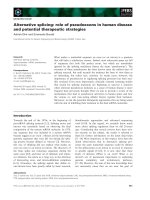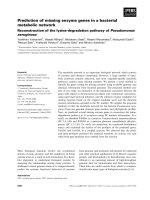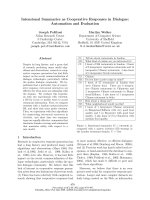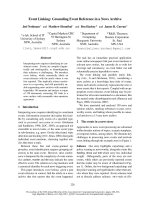báo cáo khoa học: "CCR9-CCL25 interactions promote cisplatin resistance in breast cancer cell through Akt activation in a PI3K-dependent and FAK-independent fashion" pptx
Bạn đang xem bản rút gọn của tài liệu. Xem và tải ngay bản đầy đủ của tài liệu tại đây (734.89 KB, 4 trang )
CAS E REP O R T Open Access
Thick calcification from a GIST of the stomach
penetrating into pericolic soft tissue - report
of a case
Cheng-Chan Yu
1*
, Cheng-Chung Wu
1
, Jen-I Hwang
2
, John Wang
3
and Chi-Sen Chang
4
Abstract
Thick calcification is a rare presentation of gastrointestinal stromal tumor (GIST). Penetration into gastric mucosa
and pericolic soft tissue has never been reported. We report a case of gastric GIST with cystic degeneration and
thick calcification in an 81-year old female, who presented with hematemesis and severe abdominal pain. Thick
calcification of this tumor penetrating into pericolic soft tissue was noted and successfully treated by distal
gastrectomy and partial colectomy. For gastrointestinal tumors with thick calcification, even with benign behavior,
surgical intervention should be considered for both oncological considerations and prevention of catastrophes like
perforation or penetration into surrounding soft tissue.
Introduction
Calcification within primary gastrointestinal stromal
tumor(GIST) has been reported [1-3], but thick calcifi-
cation within GIST is rare [1]. Thick calcification of a
GIST penetrating into surrounding soft tissue has never
been reported. Herein, we report the first case of thick
calcification from a gastric GIST with cystic degenera-
tion penetrating into pericolic soft tissue.
Case presentation
An 81-year-ol d female w ith hyper tension an d gout was
admitted to Taichung Veterans General Hospital due to
abdominal pain and hematemesis. She began to suffer
from intermittent epigastralgia more than 10 years ago,
and a 4 cm gastric tumor was found. The abdominal pain
got worse 2 years be fore admission, and she went to a
local hospital where abdominal CT scan revealed a gas-
tric tumor about 6 cm in length with well-circumscribed
calcification(figure 1). Surgical intervention was sug-
gested, but she declined. About 10 days before admission,
tarry stool passage was noted, and bloody vomitus was
found 1 day later. UGI scope revealed submucosal gastric
tumor with ce ntral ulceration and she was then trans-
ferred to our hospital.
Physical examination showed upper abdominal ten-
derness with mild musc le guarding. The plain radiogra-
phy showed an irregular shape calcification over upper
abdomen. UGI scope revealed deep gastric ulcer with
foreign body. CT scan showed an irregularly shaped
space-occupying lesion in front of the stomach with plate
calcifications and localized free air (figures 2 and 3).
Under the impression of perforated gastric tumor, emer-
gent laparotomy was performed. An infiltrative mass
between the stomach and transverse colon was noted
during operation. A sharp, bone-like and thick calcified
plate penetrating into the gastric mucosa and pericolic
soft tissue was observed. A submucosal tumor about
2.3 cm in size adherent to t he calcified plate was also
noted(figures4and5).Distal subtotal gastrectomy and
partial colectomy were performed. The patient was dis-
charged 13 days after operation uneventfully. Microscopi-
cally, spindle-shaped tumor cells with low mitotic
frequency (4/50 HPF) were found. Immunohistochemical
staining of the tumor demonstrated diffusely strong posi-
tive reactivity for CD 117, positive reactivity for CD34,
but negative reactivity for S100 protein and des min. The
diagnosis of the tumor was established as G IST. Due to
the small size and the paucity of mitotic figures of the
tumor located in the stomach, it was classified as very
low risk [4]. Sporadic GIST was impressed due to no
family history of GIST nor other GIST presented in this
patient.
* Correspondence:
1
Department of Surgery, Taichung Veterans General Hospital, No. 160, Sec. 3,
Taichung-Kang Rd., Taichung, 40705, Taiwan
Full list of author information is available at the end of the article
Yu et al. World Journal of Surgical Oncology 2011, 9:45
/>WORLD JOURNAL OF
SURGICAL ONCOLOGY
© 2011 Yu et al; licensee BioMe d Central Ltd. This is an Open Access article distributed under the terms of the Creativ e Commons
Attribution License ( which permits unrestricted use, distribution, and reproduction in
any medium, provide d the original work is properly cited.
Discussion
GISTs are uncommon tumors originating from the inter-
stitial cells of Cajal, which are pacemaker cells regulating
autonomic motor activity in the gastrointestinal tract.
The majority of the GISTs arise in the stomach (60-70%),
followed by small intestine, colon, esophagus, o mentum,
and mesentery [2,3]. The tumor size, mitotic figures and
the organ of origin determine the biological behavior of
GIST [4]. Patients with GIST may present with abdom-
inal pain, satiety, obstruction, or GI bleeding. However,
thick calcification of a GIST penetrating into pericolic
soft tissue has never been reported.
CT is considered to be the imaging modality of choice
for the detection, staging, surgical planning, and follow-
up of patients with GIST [5,6]. M ost tumors are seen as
well delineated soft tissue masses with heterogenous
contrast enhancement. Necrosis, calcification, and
ulceration are most commonly seen in large tumors that
present a more aggressive behavior [6].
Figure 1 Gastric ma ss with circumscribed calcification was
found by the CT scan 2 years ago. Greater thickness over the
dependent part was noted.
Figure 2 Pre-operative CT scan showed gastric mass with
curvilinear calcification penetrating into surrounding soft
tissue. Localized abscess formation was noted. A gastric tumor
adjacent to the calcification was noted.
Figure 3 3D CT reconstruction showed an unusual semicircular
calcified plate in the upper abdomen. (upper: Right side view,
lower Left side view) Ingested foreign body was excluded by history
and large size of the calcification.
Figure 4 Thick calcification with deep ulceration (black arrow)
penetrating into pericolic soft tissue with abscess formation
was noted.
Yu et al. World Journal of Surgical Oncology 2011, 9:45
/>Page 2 of 4
Focal calcification within GIST has been reported,
ranging from 10% to 50% in reported series [6-8]. How-
ever, extensive thick calcification visible on plain radio-
graph is a rare phenomenon [1,8]. Most calcifications
within GIST are circumscribed and patchy type. Pre-
vious episodes of bleeding or tumor necrosis with cystic
degeneration may cause calcification [9-11]. In our case,
the CT scan 2 years ago showed a cystic tumor with
well circumscribed calcification in the stomach, but with
greater thickness over the dependent part. The pre-
operative CT scan with 3 D reconstruction show ed gas-
tric mass with curvilinear calcification, which was identi-
cal to the operative finding. Less aggressive tumor
behavior (very low risk by pathological classification)
and long history of tumor presenting in this patient
(more than 10 years) contributed to the development
the thick calcification. The cause of the penetration was
thought to be the sharp edge of the ruptured calcified
cystic wall penetrating into t he gastric lumen and peri-
colic soft tissue.
Other gastrointestinal tumors may also contain calcifi-
cation. At least three types of calcification have been
reported in gastric cancer: mucin pool calcifications,
psammomatous calcifications, and heterotopic ossifica-
tion [9,12]. In addition, four mechanisms of calcification
within tumor have been suggested: (a) calcified scar
tissue or gr anulomatous disease is engulfed by the
tumor; (b) dystrophic calcification occurs within the
areas of tumor necrosis; (c) calcium is deposited within
the tumor as a result of a secretory function of the car-
cinoma; (d) metastatic calcification occurs as a result of
hyp ercalcemia [13,14]. Mucin-forming tissues are prone
to develop calcification due to the presence of mucinous
material and a relatively alkaline environment, which is
helpful for precipitation of calcium ions. The presence
of diffuse, punctate calcifications in gastric mass is
thought to be diagnostic for mucinous adenocarcinoma.
Dystrophic calcification occurs in ischemic and necrotic
tissue. Denatured proteins bind specifically to phosphate
ions and thereafter react with calcium ions to form
calcium phosphate precipitates. The relatively alkaline
environment readily facilitates precipitation.
An ingested foreign body in the stomach may mimic
gastric calcification. Ingested animal bone was consid-
ered initially in our case, but was excluded la ter due to
the huge size of the calcification and because a compari-
son of the CT sc an with an image obtained two years
earlier showed that this was unlikely.
In conclusion, herein we report the first case of thick
calcification from a gastric GIST with cystic degenera-
tion penetrating into pericolic soft tissue which was suc-
cessfully treated by partial gastrectomy and colectomy.
For gastrointestinal tumors with thick calcification, even
with benign behavior, surgical intervention should be
considered for both oncological considerations and pre-
vention of catastrophes like perforation or penetration
into surrounding soft tissue.
Consent
Written informed consent was obtained from the patient
for publication of this case report and any accompany-
ing images. A co py of the written consent is avail able
for review by the Editor-in-Chief of this journal.
List of abbreviations
GIST: gastrointestinal stromal tumor
Acknowledgements and Funding
The authors thank Department of medical research of Taichung Veterans
General Hospital for providing English correction. Written consent for
publication was obtained from the patient or their relative.
Author details
1
Department of Surgery, Taichung Veterans General Hospital, No. 160, Sec. 3,
Taichung-Kang Rd., Taichung, 40705, Taiwan.
2
Department of Radiology,
Taichung Veterans General Hospital, No. 160, Sec. 3, Taichung-Kang Rd.,
Taichung, 40705, Taiwan.
3
Department of Pathology, Taichung Veterans
General Hospital, No. 160, Sec. 3, Taichung-Kang Rd., Taichung, 40705,
Taiwan.
4
Department of Medicine, Taichung Veterans General Hospital,
No. 160, Sec. 3, Taichung-Kang Rd., Taichung, 40705, Taiwan.
Authors’ contributions
All authors conceived of the study, and participated in its design and
coordination and helped to draft the manuscript. All authors read and
approved the final manuscript.
Competing interests
The authors declare that they have no competing interests.
Received: 1 January 2011 Accepted: 29 April 2011
Published: 29 April 2011
References
1. Ong K, Singaporewalla RM, Tan KB: Extensive calcification within a
gastrointestinal stromal tumour: a potential diagnostic pitfall. Pathology
2006, 38(5):451-452.
2. Liegl-Atzwanger B, Fletcher JA, Fletcher CD: Gastrointestinal stromal
tumors. Virchows Arch 2010, 456(2):111-127.
3. Miettinen M, Lasota J: Gastrointestinal stromal tumors–definition, clinical,
histological, immunohistochemical, and molecular genetic features and
differential diagnosis. Virchows Arch 2001, 438(1):1-12.
Figure 5 Gastric tumor(white arrow) adherent to the calcified
plate was also noted.
Yu et al. World Journal of Surgical Oncology 2011, 9:45
/>Page 3 of 4
4. Miettinen M, Lasota J: Gastrointestinal stromal tumors: pathology and
prognosis at different sites. Semin Diagn Pathol 2006, 23(2):70-83.
5. Chourmouzi D, Sinakos E, Papalavrentios L, Akriviadis E, Drevelegas A:
Gastrointestinal stromal tumors: a pictorial review. J Gastrointestin Liver
Dis 2009, 18(3):379-383.
6. Darnell A, Dalmau E, Pericay C, Musulen E, Martin J, Puig J, Malet A, Saigi E,
Rey M: Gastrointestinal stromal tumors. Abdom Imaging 2006,
31(4):387-399.
7. Chamadol N, Laopaiboon V, Promsorn J, Bhudhisawasd V, Pagkhem A,
Pairojkul C: Gastrointestinal stromal tumor: computed tomographic
features. J Med Assoc Thai 2009, 92(9):1213-1219.
8. Levy AD, Remotti HE, Thompson WM, Sobin LH, Miettinen M:
Gastrointestinal stromal tumors: radiologic features with pathologic
correlation. Radiographics 2003, 23(2):283-304, 456; quiz 532.
9. Dickson AM, Schuss A, Goyal A, Katz DS: Radiology-Pathology Conference:
Calcified untreated gastric cancer. Clin Imaging 2004, 28(6):418-421.
10. Testroote M, Hoornweg M, Rhemrev S: Rectal GIST presenting as a
submucosal calculus. Dig Dis Sci 2007, 52(4):1047-1049.
11. Yoshida H, Mamada Y, Taniai N, Mizuguchi Y, Nakamura Y, Nomura T,
Okuda T, Uchida E, Fukuda Y, Watanabe M, et al: Spurt bleeding from a
calcificated gastrointestinal stromal tumor in the stomach. J Nippon Med
Sch 2005, 72(5):304-307.
12. Balestreri L, Canzonieri V, Morassut S: Calcified gastric cancer–CT findings
before and after chemotherapy. Case report and discussion of the
pathogenesis of this type of calcification. Clin Imaging 1997,
21(2):122-125.
13. Yasushi Itoua TRKaST: A case of intraductal tubular adenocarcinoma of
the pancreas that developed extensive intratumoral calcification.
European Journal of Radiology Extra 2009, 71(2):e65-e69.
14. Aydemir S, Savranlar A, Engin H, Cihan A, Ustundag Y, Ozer T, Dogan
Gun B: Gastric wall calcification in gastric cancer relapse: case report.
Turk J Gastroenterol 2006, 17(1):50-52.
doi:10.1186/1477-7819-9-45
Cite this article as: Yu et al.: Thick calcification from a GIST of the
stomach penetrating into pericolic soft tissue - report of a case. World
Journal of Surgical Oncology 2011 9:45.
Submit your next manuscript to BioMed Central
and take full advantage of:
• Convenient online submission
• Thorough peer review
• No space constraints or color figure charges
• Immediate publication on acceptance
• Inclusion in PubMed, CAS, Scopus and Google Scholar
• Research which is freely available for redistribution
Submit your manuscript at
www.biomedcentral.com/submit
Yu et al. World Journal of Surgical Oncology 2011, 9:45
/>Page 4 of 4









